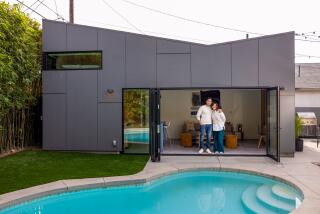When the Kids Grow Up, So Does This Playhouse
- Share via
WASHINGTON — This may be the ultimate hand-me-down: an outdoor play space designed especially for kids when they’re kids, then turned over to parents for outdoor dining and entertaining when they’re not.
“Kids grow up so fast, you’re lucky to get five to eight years of use out of any piece of play equipment,” says Oakton, Va., interior designer Loren Rosenstein.
She counts on a considerably longer life expectancy for the outdoor playhouse she’s planned for her daughter, Madeleine, 3. This space, she says, can go from toddler tea parties to preteen sleepovers and beyond.
The playroom half has a peaked roof, a round window for peering out and an adjustable floor that can be lowered to gain an extra 18 inches of headroom as Madeleine grows taller. The pergola half has a swing and a hinged floor that lifts up to reveal a sandbox beneath. A trellised rear wall is designed for a twining wisteria vine.
*
The lowered playroom floor allows 6 1/2 feet of headroom, and a hammock can replace the kiddie swing beneath the pergola. Bring in a table, chairs, some candles and voila: The space becomes an elegant outdoor dining pavilion.
Rosenstein is the principal in Loren Rosenstein Inc., a group of architects, interior designers and lighting consultants who work out of their homes and join forces on residential design projects.
Because the playhouse will be the focal point in a small backyard, Rosenstein wants it to look great and be built for easy maintenance as well as longevity.
This example echoes the architecture of her own contemporary house, but for those who want a more traditional look, the design could be dressed up with decorative latticework.
For construction material, she suggests exterior-grade, pressure-treated plywood decking that stands up to weather, and bleaches to a silvery gray. Cedar or redwood would also work. For structural integrity, the corner posts should be set in poured-concrete piers. The designer suggests aggregate for visual pizazz.
She estimates that the structure would cost about $5,000, depending on size and materials.
If space is tight, she says, you could just build a pergola: “four fat columns and a wood trellis overhead.”
Says Rosenstein, “There’s a place for plastic, but I don’t want to look at it in my beautiful garden.” Plus, she says, “there are things in a child’s life that should not be disposable and temporary.”
More to Read
The biggest entertainment stories
Get our big stories about Hollywood, film, television, music, arts, culture and more right in your inbox as soon as they publish.
You may occasionally receive promotional content from the Los Angeles Times.










